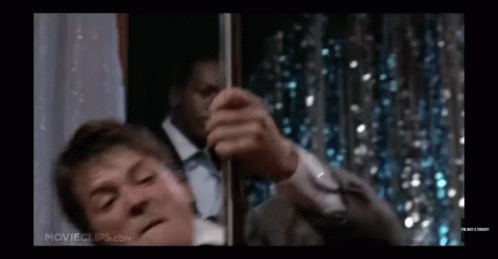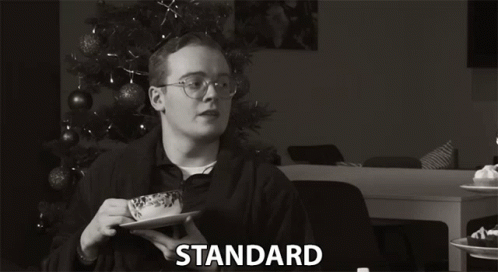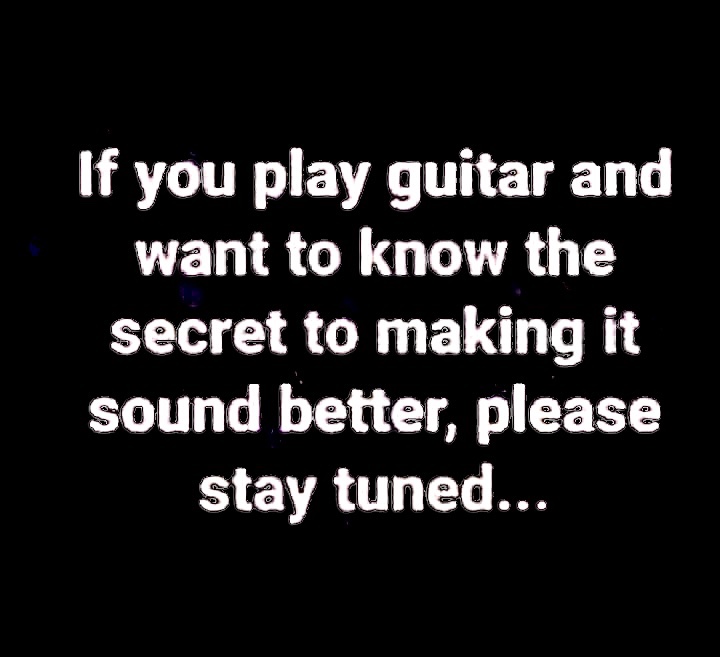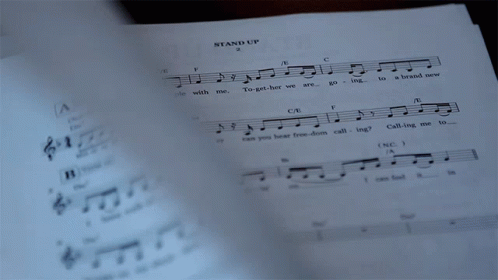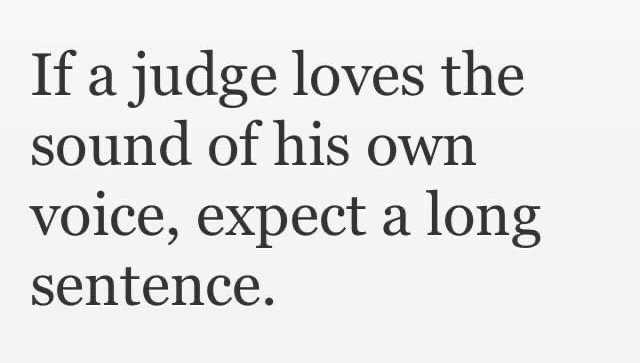Tablature
Since standard notation requires one to learn to sight read music and since rock ‘n’ rollers of the 1960’s probably didn’t want anything to do with the ‘classic’ approach to learning music since rock ‘n’ roll was probably the first rebellious period in modern music … musicians didn’t care much about standard notation and looked for a different way to notate music for guitar (and bass) that might be easier for them. The concept of tablature is very simple: since a guitar has 6 strings and the fret positions are always referred to using numbers, six lines are used to represent the six strings (4 lines if playing a 4 string bass etc) and the notes themselves are simply numbers representing the fret that is to be held. Tablature is often shown just below standard notation so that a player can also see the equivalent music in standard notation format however depending on what is being displayed (ie. if the timing of the passage you are about to play is obvious), you may also see only tablature. Similar to standard notation, tablature also uses bar lines to divide the music into smaller chunks according to the time signature. There are two types of tablature that you will see. The first is the true tablature format and looks more official and usually also has the standard notation above it and the second is a notepad text format where the lines/strings are simply dashes with numbers on them. This is a much simpler format that allows you to notate music without needing a tablature making program.
In the image below, the left tablature (tabs) are the ‘official’ tabs with the standard notation above and the tabs below. On the right, you can see the notepad version of the same music.

The format on the left is the format you will see in magazines or in some online official notation/tablature providers. They usually also include a Tablature Legend so that you can refer to it as needed however you can easily just search the web for ‘guitar tablature legend’ and you’ll see a few versions of the legend. The format on the right however doesn’t always include a legend as this is a format that is used by ‘regular joes’ that don’t have tablature creation software. You’ll see a lot of these types of tabs online as well as in the 1way2rock lessons therefore below is the notepad version of the tablature legend.
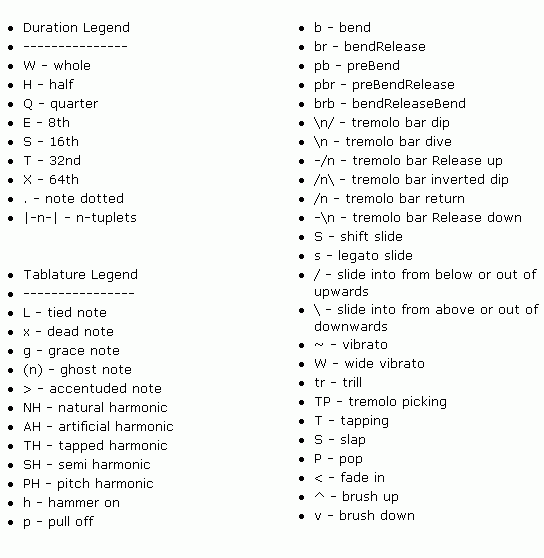
Note however that we will not go into too much detail about each technique or note listed here since we will deal with guitar techniques in a later lesson as well. If you’re just starting to play, this can confuse or discourage you at this point. Having said this, don’t be too concerned about the terms you see in the legend as most of these names are more intimidating than they are difficult to play. Just take things step by step. We’ll get there! The most important thing right now is to understand how standard notation differs from tablature and that there are multiple ways of notating music. Understanding how the strings and frets are displayed is the goal so that we can move ahead to get you playing.
Pun Of The Week
Standard Notation
The standard notation is the notation that everyone has seen at least once in their lives. It is the most common form of notation that we encounter very early on in our lives as it has become a symbol of music thanks to the great Classical composers of our time. We will not cover any advanced details of standard notation since we don’t need full knowledge at this time. We simply need to understand the most basic concepts so that you can recognize the differences in notation formats as well as the upcoming lessons. Please understand that while standard notation is considered ‘standard’ it is by no means ‘simple’ but can actually be a huge topic. In fact, standard notation is the ultimate form of notation as there is literally a symbol, instruction, or notation for everything that any instrument can do. We simply don’t need all that information at this time.
Standard Notation therefore consists of 5 horizontal lines. Each line and space represent a note.
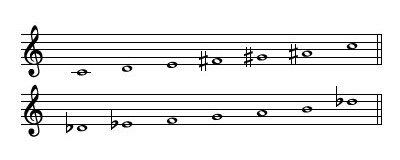
When looking at standard notation, from left to right, the first symbol you will see is the ‘clef’. Coincidentally, the word ‘clef’ is the French translation to the word ‘key’ however the word ‘clef’ in this case specifically refers to the symbols you first see on the staff (single term for staves) and although it does not refer to the ‘key’ of a song as we described in the lesson about Keys, it does provide an idea of the note ranges of a song. There are 3 different types of clefs and the only way you can really understand how they look is to refer to the following image as I don’t know how to actually describe the shapes of these symbols.
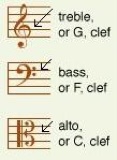
The first clef is the Treble or G clef. Just as we saw in the lessons about tone where ‘treble’ is used to describe higher frequencies, the treble clef is used for notes or phrases that fall within the higher range of pitches. The reason it is called a G clef is that the bottom part of the symbol wraps around the line where the G note would be as shown in the following image.

Similarly, the bass clef or F clef refers to the staff line representing the F note (the line between the colon or the line on which the swirl begins on). Contrary to the ‘treble clef’ the ‘bass clef’ is used for lower ranges of notes and the ‘alto’ or C clef is used for mid-ranged instruments. The staff line that runs through the center of the alto clef is designated as a C note therefore musicians interpreting music with a C clef will need to use the middle line as the C note. The clef can be moved higher up or lower than the position in the image above. Doing so would change the position of the C note and the musician will therefore need to adapt to playing the music according where the C note is indicated.
The reason the clefs are used is that some instrument ranges fall above or below the standard treble clef range therefore the notation of those instruments would be very difficult to read if left as is. By adding the appropriate clef at the beginning of a staff, the musician will have a better idea of what ranges the music spans and will also have a reference note (G, F or C) for them to be able to correctly play the notes that follow. For very high or low ranges, the treble and bass clef sometimes have a small number 8 above or below them. This would simply mean that the expected range should be an octave above or below that which the clef is pointing to.
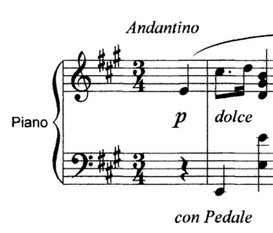
In the above image you can see that both the treble and bass clef are being used. For piano players this usually refers to which ranges of notes are to be played with the right or left hand as the right hand would player higher ranged notes (therefore the treble clef staff) and the left hand would play the notes on the staff with the bass clef. Standard Notation includes many symbols as there is a way to describe or indicate every imaginable technique since the notation would be the visual representation of the music. We cannot go through all the symbols in this lesson however I can almost guarantee you that if your instruments of choice are guitar and bass, you might find it easier to use a different type of notation that suits those instruments more. Before moving on to the next notation type I do want to point out 2 more elements in the image above. The next symbol appearing after the clefs is called the ‘key signature’. The 3 pound symbols, called ‘sharps’, indicate the key of the song therefore if the example of Mary Had A Little Lamb had this information, there would be no guessing about what key the song might be in. The 3 sharps would automatically mean that this is in the key of A Major … or any other key that shares the same notes as A Major. In fact, the key signature sharps (or flats) always appear in a similar order therefore not only would you be able to instantly know that this is in A Major, but you would also know that the 3 sharps are F, C, and G as the order of sharps is F, C, G, D, A, E, B and the order of flats is literally the reverse order B, E, A, D, G, C, F. The following image shows the number of sharps or flats for each major key (and it’s relative minor). Notice how even though more sharps appear (from left to right), the order of the sharps remains the same, as is the case for flats in the second staff below.

There is a way to determine how many sharps or flats exist in each key however this is one of those things that is probably best memorized so as to avoid having to actually calculate this before interpreting a song.
Going back to the previous image once again, the third element I will point out is the meter or time signature following the key signature. To understand how this works please refer to the lesson about Meter and Time Signature. The remaining notations include instructions about the tempo (Andantino) and the dynamics to be used while playing. In the case below, the composer is instructing the player to play ‘sweetly’ if directly translating from the Italian word ‘dolce’ however it is more likely that they prefer a lighter or softer touch. Below the bass staff we also see that the player must apply the use of the pedal from the term ‘con Pedale’.
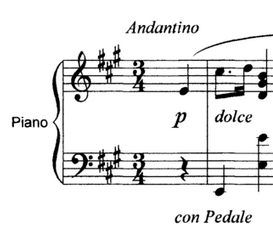
If your intention is to play piano, you would definitely benefit from diving deeper into this form of notation as there is literally a symbol or notation for every type of dynamic or song element that you can imagine. For the purpose of this lesson however, the intention is to introduce this form of notation to you and to move on to the formats that are better and more commonly used for guitar and bass instruments.
Pun Of The Week
Stay tuned!
Intro to notation
By now you have certainly understood how music is a language and how understanding specific terminology allows musicians to communicate specific concepts to one another. Like any other field of study, music has some terminology that applies specifically to music. Music however cannot simply be expressed in words as it would be too inefficient for musicians to read through texts, paragraphs, or chapters in an attempt to understand what a composer or songwriter would like them to play.
This is where Music Notation comes in as it is a collection of symbols and information that communicates various elements needed for a musician to interpret how something is to be played. In fact, it is literally a written or documented version of what is being heard just as a sound wave file is a recorded format of what you are hearing. Music Notation could easily be compared to hieroglyphics or emojis/emoticons as they are a visual representation of the music. If we research the history of music notation we will come across formats of notation that are completely different than the formats we know today however to simplify this course, we will focus on 4 main forms of music notation that are still widely used so that you too can understand them and use them to communicate ideas to your fellow musicians.
If you’ve looked ahead at the titles of the upcoming lessons, you’re probably asking yourself why the topic of Intervals, Scales, and Chords is suddenly interrupted by a lesson on Music Notation before getting into the details of Intervals. The reason is simply that I would like for you to be able to visualize how notes appear in their various notation formats so that we can then dive deeper into the details of Intervals, Scales, and Chords.
The Music Notation formats we will cover in the next few lessons include:
– Standard Notation (Musical Staves)
– Tablature (Guitar Neck Diagrams)
– Graphic Notations (Guitar Neck Chord Diagrams)
– Lead Sheets (Chord Progression Charts)
Pun Of The Week
Queen of Clubs
Analyze This!
If we analyze a simple melody such as Mary Had A Little Lamb, we see that the melody is made up of 7 notes. The word ‘Ma-ry’ is made up of 2 notes, one of which is lower than the first.

Since we don’t know what key or scale the song is in from the image, we don’t know what groups of notes apply to this melody however since that is the case, we can use the numbered scale degrees if we needed to describe the melody to another musician.
If you sing the melody (assuming you are familiar with this tune already) you’ll notice that the word had is the word that feels the strongest. Even though the word lamb is the longest in duration, the word had feels like note the other notes pull towards, therefore we can assume that it is the tonic of the key. Therefore the melody, using scale degrees, would be : 3 2 1 2 3 3 3. To clarify, the words and scale degrees for this melody would be Ma(3)-ry(2) had(1) a(2) li(3)-ttle(3) lamb(3).
The interval between Ma- and -ry is actually 2, just as is the case between -ry and had or between had and aand a and li-. The interval between li- and -ttle and -ttleand lamb however is a 1 as there is no distance between one or the other since they are the same note. So why did I previously state that the melody in scale degrees is 3 2 1 2 3 3 3? The reason is that the interval I am describing is the interval between the word and the tonic. Therefore if we assume that the word had is the tonic and therefore the 1, then the Ma- of Mary is 3 notes away from had. The -ry is 2 away from had and a is also 2 away from had etc. The fact is that intervals can be used to describe either the distance between two notes that are consecutive as well as a note and it’s relationship to the topic. It really depends on the topic of discussion.
If the word had is a C note however and we feel that this is the tonic, then it may be safe to assume the song is in the key of C Major. I say it ‘may be safe to assume’ because we don’t necessarily know this at 100% since the image does not offer any other information that can confirm this for us at this point. We would strictly be making this decision based on what we ‘feel’ or about what we might already know about the song. If the song is unknown to us however, we might be completely wrong as we don’t have enough notes to make a decision on. Even though there are 7 notes, there are only 3 ‘different’ notes and these 3 notes can belong to any number of keys. If however the melody provided to us made use of all 7 notes and if we then notice that the 7 notes do not consist of any accidentals (sharps or flats -OR- black keys of a piano) it would make it that much safer to assume that we are in the key of C Major since C Major does not have any accidentals.
This section is a great way to demonstrate how the material we’ve covered so far might be applied in a discussion and how the new language that is available to us at this point allows us to communicate something that we otherwise would not have been able to put in words. This new knowledge allows you to discuss topics like sound, music, rhythm and time without even making or hearing a sound. That is pretty amazing if you think about how words or language alone allow us to describe things that we would otherwise have to demonstrate by actually playing or listening to an instrument. This demonstrates how music theory has great value in helping musicians communicate with one another without each necessarily requiring an instrument (that they both understand to boot!). Congratulations on your progress so far! Keep up the good work!
This actually makes a great segue to the next topic because the above excerpt of “Mary had a little lamb” is a good example of how we were not able to come to a definite conclusion on the key of the song. I mentioned that if all 7 notes were available to us that it might be easier to know what key the song is in however there are other ways of knowing this information as well that would have provided that clarification even with the 3 notes that were available to us.
